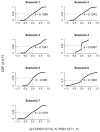Combining biomarkers to optimize patient treatment recommendations
- PMID: 24889663
- PMCID: PMC4248022
- DOI: 10.1111/biom.12191
Combining biomarkers to optimize patient treatment recommendations
Abstract
Markers that predict treatment effect have the potential to improve patient outcomes. For example, the OncotypeDX® RecurrenceScore® has some ability to predict the benefit of adjuvant chemotherapy over and above hormone therapy for the treatment of estrogen-receptor-positive breast cancer, facilitating the provision of chemotherapy to women most likely to benefit from it. Given that the score was originally developed for predicting outcome given hormone therapy alone, it is of interest to develop alternative combinations of the genes comprising the score that are optimized for treatment selection. However, most methodology for combining markers is useful when predicting outcome under a single treatment. We propose a method for combining markers for treatment selection which requires modeling the treatment effect as a function of markers. Multiple models of treatment effect are fit iteratively by upweighting or "boosting" subjects potentially misclassified according to treatment benefit at the previous stage. The boosting approach is compared to existing methods in a simulation study based on the change in expected outcome under marker-based treatment. The approach improves upon methods in some settings and has comparable performance in others. Our simulation study also provides insights as to the relative merits of the existing methods. Application of the boosting approach to the breast cancer data, using scaled versions of the original markers, produces marker combinations that may have improved performance for treatment selection.
Keywords: Biomarker; Boosting; Model mis‐specification; Treatment selection.
© 2014, The International Biometric Society.
Figures

Comment in
-
Discussion of "Combining biomarkers to optimize patient treatment recommendation".Biometrics. 2014 Sep;70(3):707-10. doi: 10.1111/biom.12187. Epub 2014 Jun 2. Biometrics. 2014. PMID: 24888979 Free PMC article. No abstract available.
-
Discussion.Biometrics. 2014 Sep;70(3):710-3. doi: 10.1111/biom.12188. Epub 2014 May 30. Biometrics. 2014. PMID: 24889101 Free PMC article. No abstract available.
-
Discussion of combining biomarkers to optimize patient treatment recommendations.Biometrics. 2014 Sep;70(3):713-6. doi: 10.1111/biom.12189. Epub 2014 May 30. Biometrics. 2014. PMID: 24889265 Free PMC article.
-
Discussion of "Combining biomarkers to optimize patient treatment recommendations" by Chaeryon Kang, Holly Janes, and Ying Huang.Biometrics. 2014 Sep;70(3):716-9. doi: 10.1111/biom.12190. Epub 2014 Jun 2. Biometrics. 2014. PMID: 24889402 No abstract available.
-
Rejoinder: Combining biomarkers to optimize patient treatment recommendations.Biometrics. 2014 Sep;70(3):719-20. doi: 10.1111/biom.12192. Epub 2014 May 30. Biometrics. 2014. PMID: 24889787 Free PMC article. No abstract available.
References
-
- Albain K, Barlow W, Ravdin P, Farrar W, Burton G, Ketchel S, Cobau C, Levine E, Ingle J, Pritchard K, et al. Adjuvant chemotherapy and timing of tamoxifen in postmenopausal patients with endocrine-responsive, node-positive breast cancer: a phase 3, open-label, randomised controlled trial. The Lancet. 2010;374:2055–2063. - PMC - PubMed
-
- Albain K, Barlow W, Shak S, Hortobagyi G, Livingston R, Yeh I, Ravdin P, Bugarini R, Baehner F, Davidson N, et al. Prognostic and predictive value of the 21-gene recurrence score assay in postmenopausal women with node-positive, oestrogen-receptor-positive breast cancer on chemotherapy: a retrospective analysis of a randomised trial. The Lancet Oncology. 2010;11:55–65. - PMC - PubMed
-
- Breiman L, Friedman J, Stone C, Olshen R. Classification and regression trees. Chapman & Hall/CRC; 1984.
Publication types
MeSH terms
Substances
Grants and funding
LinkOut - more resources
Full Text Sources
Other Literature Sources
Medical

